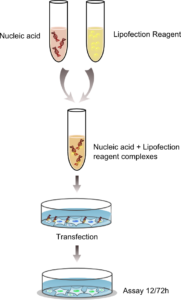Contents
Lipofection is a lipid-based transfection technology which belongs to biochemical methods also including polymers, DEAE dextran and calcium phosphate.
The principle of lipofection is to associate nucleic acids with cationic lipid formulation. The resulting molecular complexes, known as lipoplexes, are then taken up by the cells.
The main advantages of lipofection are its high efficiency, ability to transfect all types of nucleic acids in a wide range of cell types, ease of use, reproducibility, and low toxicity. In addition, this method is suitable for all transfection applications (transient, stable, co-transfection, reverse, sequential or multiple transfections…), high throughput screening assays, and has also shown good efficiency in some in vivo models.
How Does It Work?

The lipid-based reagents used for lipofection are generally composed of synthetic cationic lipids, often mixed with helper lipids such as DOPE (1,2-dioleoyl-phosphatidyl-ethanolamine) or cholesterol. These lipid mixtures form liposomes or micelles with an overall positive charge at physiological pH and are able to form complexes (lipoplexes) with negatively charged nucleic acids through electrostatic interactions. The association of the lipid-based transfection reagent with nucleic acids results in tight compaction and protection of the nucleic acids and these cationic complexes are mainly internalised by endocytosis.
Once inside the cells, two mechanisms have been described for the release of nucleic acids into the cytoplasm. One relies on the buffering capacity of endosomes for polycationic residues (called the “proton sponge effect”). The other describes the ability of cellular negatively charged lipids to neutralise the cationic residues of the transfection reagent leading to destabilisation of endosomal membranes.
Finally, the cellular and molecular events leading to gene expression after the nuclear uptake of DNA (not required for siRNA) remain highly speculative. However, the significance of cell division on transfection efficiency favours the assumption that nuclear membrane disruption during the mitosis process promotes DNA nuclear uptake. Nonetheless, transfection of primary cells (non-dividing) and in vivo is also achievable with lipofection demonstrating that DNA can make its way to the nucleus where gene expression takes place.
TEE-Technology
Cationic lipids (lipoplexes) and their polymers (polyplexes) are the most employed non-viral gene delivery systems. The TEE-Technology (Triggered Endosomal Escape) combines and exploits the properties of both lipoplexes and polyplexes to achieve extremely efficient nucleic acid delivery into cells. Indeed, this new generation of lipopolyamines contains a lipophilic part, such as lipids, and a charged polyamine moiety, such as cationic polymers. These moieties act in synergy to ensure the tight compaction and protection of nucleic acids and a very efficient destabilisation of the endosomal membrane which allows the release of large amounts of nucleic acids in the cytosol and DNA nuclear uptake. Furthermore, a particular focus on the synthesis of fully biodegradable entities was integrated into this technology. In this way, the transfection reagents do not interfere with cellular mechanisms, high cell viability is maintained in every experiment and any potential secondary effects are avoided.
The major TEE-Technology advantages are:
- Compaction of DNA in nanoparticles efficiently internalised by cells.
- Protection of nucleic acids against nuclease degradation.
- Efficient membrane destabilisation and DNA delivery.
- Highly efficient even with low amounts of nucleic acids.
- Biodegradability.
What Are The Applications?
Transfection efficiency combined with high transgene expression level or high gene silencing and minimised cytotoxicity depends on multiple critical parameters. Those factors include cell type, plasmid DNA characteristics (size, promoter, reporter gene) & purity, siRNA sequence & purity, cell culture conditions (medium with or without serum, cell number, absence of contaminations…), amount of nucleic acids and reagents and transgene assays to name a few. Consequently, transfection reagents need to be specifically designed according to the nucleic acids to be delivered (DNA, siRNA, mRNA, ODN, shRNA etc.) and the cell types used in order to achieve optimal efficiency.
The lipofection method is especially suitable for immortalised cells.
How Do I Use Lipofection Reagents?
The protocol is a very straightforward and easy procedure:
- Prepare the DNA and the Reagent solutions.
- Mix them together and incubate for 20 minutes.
- Add to your cells.
Originally posted by OZ Biosciences on: https://ozbiosciences.com/content/11-lipofection-technology
Caltag Medsystems is the distributor of OZ Biosciences products in the UK and Ireland. If you have any questions about these products, please contact us.
